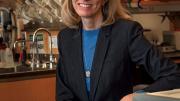As a child, Kari Nadeau spent a few years living on a houseboat where her father, a research scientist at the Environmental Protection Agency, studied the polluted estuaries of the New Jersey shore. She doesn’t remember any Huckleberry Finn-esque adventures—just wheezing: the impure water gave her asthma and a severe mold allergy. As soon as her family moved, her health improved. She learned a valuable first lesson that “decreasing exposure improves the clinical outcome,” said Nadeau, who recently became chair of the department of environmental health at the Harvard T. H. Chan School of Public Health. Inspired by her father and mother, a public health nurse, Nadeau studied biology at Haverford College before graduating with an M.D./Ph.D. from Harvard Medical School in 1995. Now, she investigates the environmental factors affecting the development of asthma and allergies. During a 20-year career at Stanford, she pioneered a process that helps children conquer multiple food allergies simultaneously by consuming portions of their allergens in a controlled setting. She makes her young patients feel comfortable by treating them “as if they were my own children,” adding to her five at home (including two sets of twins). As a physician, she’s involved in reactive care, but as an entrepreneur and public health expert, she’s interested in preventive measures. She coined the “six D’s” to help prevent infant allergy development—live with a Dog, play in the Dirt, get vitamin D, avoid Dry skin, use less Detergent, and ignore DNA (when it comes to allergies, genetics are not fate). Now, returning to Boston, Nadeau has added a seventh D for herself: Dopamine. As a medical student, she ran marathons, “so my fun is still going out on the greenways and jogging the Emerald Necklace.” It helps that Boston’s “dirty water” is much cleaner than the 1970s-era estuaries of the Jersey shore.
Kari Nadeau
Kari Nadeau
Multi-allergy immunotherapy pioneer Kari Nadeau returns to Harvard

Kari NadeauPhotograph by Stu Rosner
You might also like
Trump Administration Appeals Order Restoring $2.7 Billion in Funding to Harvard
The appeal, which had been expected, came two days before the deadline to file.
At Harvard, AI Meets “Post-Neoliberalism”
Experts debate whether markets alone should govern tech in the U.S.
Sam Liss to Head Harvard’s Office for Technology Development
Technology licensing and corporate partnerships are an important source of revenue for the University.
Most popular
Explore More From Current Issue

Introductions: Dan Cnossen
A conversation with the former Navy SEAL and gold-medal-winning Paralympic skier

For Campus Speech, Civility is a Cultural Practice
A former Harvard College dean reviews Princeton President Christopher Eisgruber’s book Terms of Respect.






